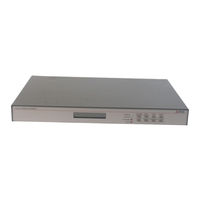Arbiter Systems 1133A Power Measurement Manuals
Manuals and User Guides for Arbiter Systems 1133A Power Measurement. We have 2 Arbiter Systems 1133A Power Measurement manuals available for free PDF download: Operation Manual, Quick Setup Manual
Arbiter Systems 1133A Operation Manual (192 pages)
GPS-SYNCHRONIZED POWER QUALITY REVENUE STANDARD
Brand: Arbiter Systems
|
Category: Recording Equipment
|
Size: 4 MB
Table of Contents
-
-
Introduction24
-
-
Power Inlet27
-
Event Inputs28
-
-
-
Introduction30
-
-
Event Inputs39
-
-
-
-
Startup48
-
-
Power Key53
-
Energy Key53
-
Flicker Key54
-
-
-
Introduction56
-
Main Toolbar58
-
View Menu61
-
Edit Menu61
-
-
Introduction62
-
-
-
-
Introduction68
-
-
Setup77
-
-
-
-
Introduction90
-
-
-
Introduction93
-
-
-
-
Hysteresis Plot103
-
-
Introduction111
-
-
-
Introduction123
-
-
Energy Values128
-
Voltage Values128
-
Sequence Values129
-
Flicker129
-
Harmonics129
-
-
-
-
Overview131
-
Current Inputs131
-
Voltage Inputs132
-
Self Calibration132
-
Error Analysis132
-
Signal Sampling132
-
Power and Energy132
-
DC Offsets135
-
Harmonics136
-
Flicker137
-
Interruptions137
-
Phase Balance138
-
Load Balance138
-
Contact Outputs139
-
Event Inputs139
-
Serial Channels139
-
-
-
Scope144
-
Standard Options145
-
-
Input Voltage146
-
Input Current146
-
IP Address150
-
-
Flicker151
-
Limit Alarms152
-
Synchronization153
-
-
-
Introduction155
-
-
Dnp 3.0155
-
Modbus155
-
Scale Factors156
-
-
Energy Values163
-
Trigger Status164
-
-
-
Introduction173
-
Description173
-
Installation174
-
-
C IRIG-B Primer
176-
Introduction176
-
-
-
Introduction181
-
Advertisement
Arbiter Systems 1133A Quick Setup Manual (4 pages)
Brand: Arbiter Systems
|
Category: Measuring Instruments
|
Size: 0 MB

